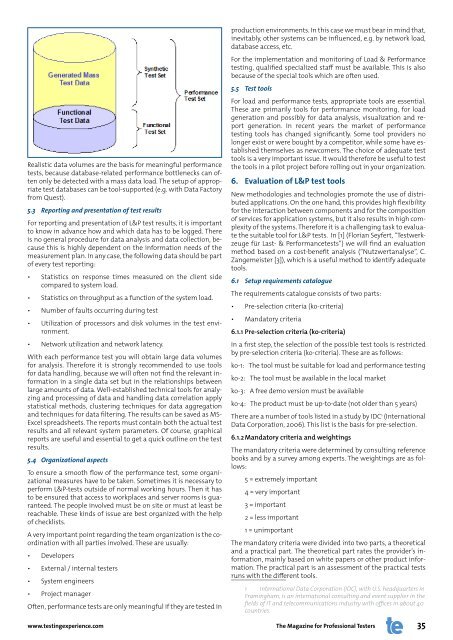Agile Performance Testing - Testing Experience
Agile Performance Testing - Testing Experience
Agile Performance Testing - Testing Experience
You also want an ePaper? Increase the reach of your titles
YUMPU automatically turns print PDFs into web optimized ePapers that Google loves.
Realistic data volumes are the basis for meaningful performance<br />
tests, because database-related performance bottlenecks can often<br />
only be detected with a mass data load. The setup of appropriate<br />
test databases can be tool-supported (e.g. with Data Factory<br />
from Quest).<br />
5.3 Reporting and presentation of test results<br />
For reporting and presentation of L&P test results, it is important<br />
to know in advance how and which data has to be logged. There<br />
is no general procedure for data analysis and data collection, because<br />
this is highly dependent on the information needs of the<br />
measurement plan. In any case, the following data should be part<br />
of every test reporting:<br />
• Statistics on response times measured on the client side<br />
compared to system load.<br />
• Statistics on throughput as a function of the system load.<br />
• Number of faults occurring during test<br />
• Utilization of processors and disk volumes in the test environment.<br />
• Network utilization and network latency.<br />
With each performance test you will obtain large data volumes<br />
for analysis. Therefore it is strongly recommended to use tools<br />
for data handling, because we will often not find the relevant information<br />
in a single data set but in the relationships between<br />
large amounts of data. Well-established technical tools for analyzing<br />
and processing of data and handling data correlation apply<br />
statistical methods, clustering techniques for data aggregation<br />
and techniques for data filtering. The results can be saved as MS-<br />
Excel spreadsheets. The reports must contain both the actual test<br />
results and all relevant system parameters. Of course, graphical<br />
reports are useful and essential to get a quick outline on the test<br />
results.<br />
5.4 Organizational aspects<br />
To ensure a smooth flow of the performance test, some organizational<br />
measures have to be taken. Sometimes it is necessary to<br />
perform L&P-tests outside of normal working hours. Then it has<br />
to be ensured that access to workplaces and server rooms is guaranteed.<br />
The people involved must be on site or must at least be<br />
reachable. These kinds of issue are best organized with the help<br />
of checklists.<br />
A very important point regarding the team organization is the coordination<br />
with all parties involved. These are usually:<br />
• Developers<br />
• External / internal testers<br />
• System engineers<br />
• Project manager<br />
Often, performance tests are only meaningful if they are tested in<br />
www.testingexperience.com<br />
production environments. In this case we must bear in mind that,<br />
inevitably, other systems can be influenced, e.g. by network load,<br />
database access, etc.<br />
For the implementation and monitoring of Load & <strong>Performance</strong><br />
testing, qualified specialized staff must be available. This is also<br />
because of the special tools which are often used.<br />
5.5 Test tools<br />
For load and performance tests, appropriate tools are essential.<br />
These are primarily tools for performance monitoring, for load<br />
generation and possibly for data analysis, visualization and report<br />
generation. In recent years the market of performance<br />
testing tools has changed significantly. Some tool providers no<br />
longer exist or were bought by a competitor, while some have established<br />
themselves as newcomers. The choice of adequate test<br />
tools is a very important issue. It would therefore be useful to test<br />
the tools in a pilot project before rolling out in your organization.<br />
6. Evaluation of L&P test tools<br />
New methodologies and technologies promote the use of distributed<br />
applications. On the one hand, this provides high flexibility<br />
for the interaction between components and for the composition<br />
of services for application systems, but it also results in high complexity<br />
of the systems. Therefore it is a challenging task to evaluate<br />
the suitable tool for L&P tests. In [1] (Florian Seyfert, “Testwerkzeuge<br />
für Last- & <strong>Performance</strong>tests”) we will find an evaluation<br />
method based on a cost-benefit analysis (“Nutzwertanalyse”, C.<br />
Zangemeister [3]), which is a useful method to identify adequate<br />
tools.<br />
6.1 Setup requirements catalogue<br />
The requirements catalogue consists of two parts:<br />
• Pre-selection criteria (ko-criteria)<br />
• Mandatory criteria<br />
6.1.1 Pre-selection criteria (ko-criteria)<br />
In a first step, the selection of the possible test tools is restricted<br />
by pre-selection criteria (ko-criteria). These are as follows:<br />
ko-1: The tool must be suitable for load and performance testing<br />
ko-2: The tool must be available in the local market<br />
ko-3: A free demo version must be available<br />
ko-4: The product must be up-to-date (not older than 5 years)<br />
There are a number of tools listed in a study by IDC1 (International<br />
Data Corporation, 2006). This list is the basis for pre-selection.<br />
6.1.2 Mandatory criteria and weightings<br />
The mandatory criteria were determined by consulting reference<br />
books and by a survey among experts. The weightings are as follows:<br />
5 = extremely important<br />
4 = very important<br />
3 = important<br />
2 = less important<br />
1 = unimportant<br />
The mandatory criteria were divided into two parts, a theoretical<br />
and a practical part. The theoretical part rates the provider’s information,<br />
mainly based on white papers or other product information.<br />
The practical part is an assessment of the practical tests<br />
runs with the different tools.<br />
1 International Data Corporation (IDC), with U.S. headquarters in<br />
Framingham, is an international consulting and event supplier in the<br />
fields of IT and telecommunications industry with offices in about 40<br />
countries.<br />
The Magazine for Professional Testers<br />
35









